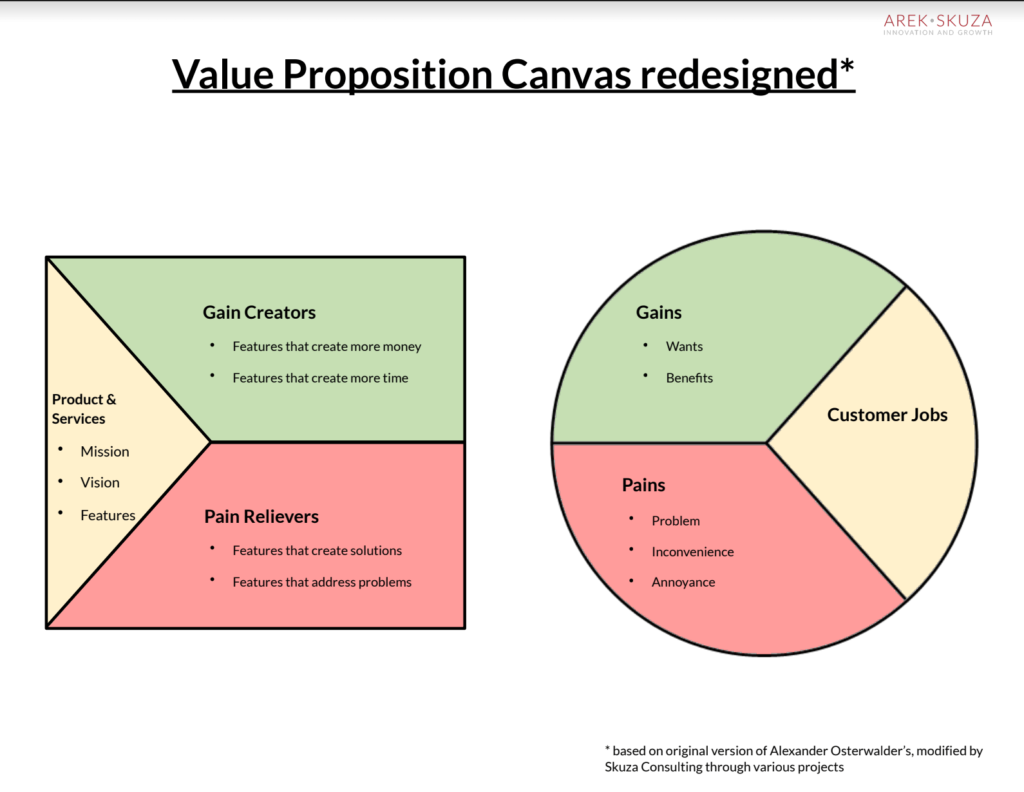Welcome to the third step of the eight steps framework designed to help you build a robust go-to-market strategy. Today, I am happy to introduce you to the Value Proposition Design and Test step.
Why you probably should read this article and what will you learn?
- What are the common reasons for designing a weak value proposition and fail the product eventually?
- What is the value and why you should start with the value proposition draft, not with a product design?
- What is the difference between customer and user and how it influences the design and validation of a value proposition
- How to design and test an initial value proposition?
Business development managers, program managers, and product managers contribute value to their customers / end-users through their product portfolio.
Their primary objective is to create so much value for customers that they choose their products, stay with the company (driving retention), and recommend the product or service over any other option.
Yet, 95% of launched products don’t provide value and don’t get significant traction.
Find a few reasons for the wrong approach in designing a value proposition that accelerate go-to-market strategy.
1) Business Development Managers lose the opportunity to launch a product that would indeed provide value. Growth is compound – by missing the opportunity to offer a compelling value proposition this time around, they’ve stunted all of our future growth permanently.
2) Product managers lose out on potential revenue, which brings them closer to running out of profitability or destroying current or future margins. That means they may lose resource allocation, or investors might abandon the project, or the venture comes one step closer to bankruptcy.
3) Competitors get ahead of the business by launching products of more persuasive value.
4) Business managers lose the confidence of their customers, and they lose the buy-in of their internal stakeholders.
Never miss a post. Subscribe to my The Innovation Letter here.
The most common reasons for designing a weak value proposition come from a few traps:
- managers might think that creating a “sexy” product (e.g., voice-enabled bot or AI-based software) will provide value automatically experimenting and validating the value with the end-user
- business people think that they know their customers already, and, as a consequence, they create a product roadmap based on imagined assumptions with no proof to back them
- the market and competitive landscape (check my post about it) might change or clients perception has evolved, and now the managers are operating off of outdated knowledge that causes them to launch products/services of poor value
- Product managers might forget that their customers and payers are different personas, and that product needs to satisfy the expectations of both. This happens most commonly with the marketplace and SaaS products.
To stop falling into these pitfalls, managers, therefore, need to be clear-eyed about the definition of the value proposition.
What Is Value and why business managers should start with defining one?
Value is a currency. Your customer exchanges the currency for your product. If they don’t make more out of it than what they invested in, they certainly won’t be using your product again (reducing retention and influencing margins).
Your end-users always invest their irrecoverable time to understand your offering and to learn how to use it. When a customer decides to use your product or service, they are putting their brand at risk.
So, how do you make sure that your clientele gets value out of your offering?
You need to make sure you start with a value proposition as the foundation of any new product you are about to launch or the existing one you are about to redesign. Usually, teams start with building a product and then thinking about the value proposition. It’s the wrong order.
At its heart, a value proposition is an offer you make to the customers, and it sounds like this: dear customer pay this price (currency) to achieve this set of benefits. If they agree to take it, you shipped them value (you better have more powerful ones than your competitors); if they don’t accept your offer, then you don’t have a chance to provide them value and see the reactions.
Let’s break down how you can leverage value propositions based approach to ensure that your product does a job in delivering positive returns for your customers (delivering more value than the investment made by the end-user).
I’ll break the Designing and Validating Value Proposition topic into two separated posts:
- Designing the client and crafting an opening value proposition (this post).
- Testing, iterating and validating a value proposition (link to the article).
For this article, I will focus on building blocks of a great value proposition, which are the target customer and the target user.
Identify the Customer and the User
One of the most common mistakes in the tremendous go-to-market strategy is that product managers or business development managers use a product to decide which and what type of target customers and users to serve. Rather than starting from a well-specified audience and then building a product around the audience’s needs (pains and gains, here is the article about pains and gains which you might find interesting).
You shouldn’t bring the new or redesigned offering (products/services) into the value proposition. Your offering is a vehicle to carry the value proposition – it shouldn’t drive the value proposition (the order makes a huge difference).
If you start with the customer and the user, then your product becomes the vehicle, if you start with the product, then the product turns to the driving force.
The customer is somebody who pays for your product (exchange the currency like money, data, time). Customers share their currency mostly to remove pains and receive gains (not the other ways). It’s vital to ask yourself the series of the following questions to start working on the value proposition:
What are the customer’s pains (for instance: I can’t pay for my rent by the card, all they accept is a bank transfer which cost me a 3% fee)?
What are the jobs that they’re forced to do that they can’t get done, or it takes a lot of effort to get them done? (for instance: I need a service desk to answer my question, but I can’t call them because they are always busy)
The user is somebody who uses your product or service to solve pains and get gains. User can be a customer (for instance, a small company owner pays for the invoicing software and use it). In evaluating users and learning their expectations, think about the pain that they face (slightly different than customers’ pains).
You shouldn’t sit in a conference room to define with these customer and user pains and gains. You should get out of the office and craft the value proposition with customers and users. You can craft hypotheses with your team, but you need to learn directly from customers to back up your judgment and define a particular customer and user niche.
Design value proposition like a pro.
Value proposition canvas is a tool that helps to align the value proposition of the product or service with what the customer considers as the “pain removal” and “gains provider.” The tool helps to make the offering a better fit for the market. The tool dramatically reduces the chances of product failure.
The value proposition canvas is excellent for both improving an existing offering or launching an entirely new product.

How to work with the canvas:
- Start with the customer jobs and list all the functional (f.i. customer needs to configure a laptop for 2 hours), emotional (f.i. need to ask for the first date face to face), and social (f.i. customer needs to play with the kid after the school) jobs.
- Define pains and gains. Pains are all factors which bring obstacles and pitfalls in the path of customers getting the job done. Gains defines the benefit in the form of positive outcomes that the customers expect, want, or will be amazed by, and which will increase the probability of paying (currency) for a value proposition delivery (product or service).
- Define pain relievers, which answer the question of how your products and services will remove the customers’ pains before, during, and after the job is done.
- Define gain creators. These specify how your offering formulates customer gains. A school bus school gives parents (customers) both the safety and convenience while transporting kids (users).
Finally, the products and services definition comes. It is a list of products’ and services’ specific features which you offer or will offer to the customers to remove pains and get gains. The list is a result of the analysis of pains, gains, pain relievers, and pain creators, not the other way. It is another argument why starting with the product is 95% failure. By bringing features first, you are just guessing what will get gains and remove pains.
The benefit of starting with a Value Proposition not with the product.
Contemplate the essential benefits that your product team can deliver to solve the customers’ and users’ pains. Having a precise recognition of your internal capabilities and competitive landscape will significantly help you recognize the gains that your company can deliver.
Furthermore, you should enrich your internal analysis with a full understanding of what is going outside of your company (here is how to conduct market mapping).
Please keep in mind; the key is to remove real, existing, and vast pain for the target customer or the user (and ideally both). Not only your new or redesigned product need to be relevant, but it also needs to move the needle (offer higher value proposition than existing alternatives). How does your product change the magnitude of the pain that your customers and users are feeling?
If you start with the product, you don’t have a chance to put money on the right horse. You will be guessing. Moreover, you will try to convince customers they are wrong. If you start with the value proposition first, you will build a product that reflects customers’ expectations. Changing the customer’s expectations is hard and expensive. You don’t want to do it.
Summary
To build winning products and services, I believe, business development and product managers should begin with a value proposition first. A powerful value proposition always starts with the customer as the center of the go-to-market strategy. Taking it from there, I think, you should identify customers’ and users’ key pains, but don’t do it in your office, get out of the building. Then it will be clear how you can provide unique benefits to solve those pains. Afterward, design your first value proposition (don’t build a product yet), test the value with customers.
WOULD YOU LIKE AREK TO WORK WITH YOUR ORGANIZATION?

If you are interested in working with Arek Skuza for a business project, workshop, speech or presentation, please fill out the form here.

